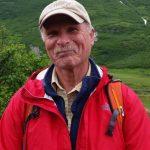
On May 31, 2023, the West lost one of its most ardent wildlife advocates, Dr. James (Jim) Bailey of Belgrade, Montana died peacefully at home. He was 89.
I saw Jim in Bozeman in mid-April. He attended a lecture I gave for Earth Day Celebrations and then, during the same week, gave a talk on wild bison.
Jim ceaselessly advocated for the restoration of American bison. He was one of the few people that I knew that also promoted wildness. What Jim meant by “wildness” is that evolutionary processes would dominate and influence wildlife.
Jim was particularly interested in bison. He wrote American Plains Bison: Rewilding an Icon in 2013. In particular, Jim was committed to Yellowstone bison.
He has pointed out that bison are not endangered. There are hundreds of thousands of bison, most on commercial ranches. But the biggest threat to bison isn’t extinction but the extinction of wild bison and of wildness. Domestication is occurring among nearly all bison herds from tribal herds to private ranches to numerous partially wild herds in between.
Yellowstone bison are the only significant bison herd in the United States that has been more or less continuously wild. By wild, we mean the bison were influenced mainly by natural processes like predators, drought, harsh winters, tournament breeding, and selection for mobile and hardy animals.
Jim’s dream was to see public wild bison restored to the Charles M. Russell Wildlife Refuge in central Montana. To Jim, restoring bison or any other animal was mainly about a hands-off approach to management. And to ensure sufficient genetic diversity and resilence, you need a herd with several thousand to many thousands, and few herds meet this minimum size.
In an interview in 2014, Bailey explained his concern: “Most people think there is no issue with the bison because Ted Turner owns a bunch, but we’re domesticating them,” Bailey said. “We’re stripping out the wild genes and replacing them with domestic genes. We’re losing the wild bison.”
Jim started the Montana Wild Bison Restoration Coalition. Jim was concerned that nearly all bison in the United States are domesticated. Worse, they are getting more domesticated all the time due to management and policy decisions such as the annual slaughter of Yellowstone bison near Gardiner, which kills all bison, not the individuals that native predators or other mortality factors like starvation might kill. He has listed the ten leading causes of bison loss of wild genes.
Jim grew up in Chicago, but early in his college studies decided that he was interested in a profession in wildlife. So he did graduate work at the State University of New York at Syracuse and the University of Michigan. He eventually got a Ph.D. from the State University of New York at Syracuse.
In 1968 he left the East for an instructor’s position in wildlife management at the University of Montana. This was followed by a professorship at Colorado State University, where he retired as a full professor in 1990.
He then served as Assistant Director of the Conservation Services Division in the New Mexico Department of Game and Fish, overseeing endangered species programs, habitat conservation, and watchable wildlife. He eventually moved to Belgrade and actively promoted the restoration of wild bison.
Unfortunately, Jim died before achieving his dream of wild bison restoration. But others, including myself, continue to advocate for wild bison.
Montana lost an effective wildlife advocate, but his vision will continue.


Comments
Jim is on his way to the Great Wild in the sky. And we, as conservationists, are better for the tireless work he did while among us. I never met him. I support the work MT Wild Bison Restoration Coalition did. No punches pulled. Just an honest, biocentric approach to dealing with a difficult issue. He will be missed.
We should all be a little more active on the bison issue in his honor. And I suggest we all give a little extra to the group to continue his fine work.
We need people like Jim to continue his work. He was right we are losing our wild life.
Based on your series about the YNP bison, I am reading his book American Plains Bison, Rewilding an Icon”
I knew Jim when he worked for NMDGF. He was our strongest ally within the department and was a leader in our effort to reform wildlife governance in the state before most of us were aware of the systemic issues with state wildlife management. He was an inspiration to me to launch Wildlife for All all these years later.
Sad to hear. While I wasn’t familiar with this wonderful man, I’m very appreciative of everything he has done for bison, and protecting our last remaining wild lands.
Jim was my mentor and inspiration, starting as a young biologist at CSU. He got me my first wildlife job as a “goat boy” on a mountain goat study in Colorado. We kept in touch over the years, and I was always amazed and inspired by his intellect and determination to conserve wild things. My thoughts go out to Nan, Tina and Mike. He was one of the great!
Jim Bailey was one of my professors when I attended Colorado State University for my M.S. from 1978-80. He was on my committee and a leader in big game management. Great guy.